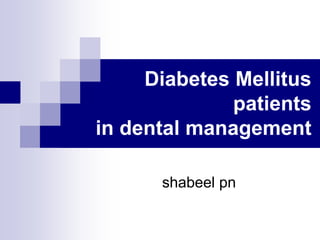
Diabetes and Dentistry Presentation by Dr Ali.pptx
- 1. Diabetes Mellitus patients in dental management shabeel pn
- 2. Introduction Diabetes mellitus is a metabolic disorder characterized by relative or absolute insufficiency of insulin, and resultant disturbances of carbohydrate metabolism. The major function of insulin is to counter the concerted action of a number of hyperglycemia- generating hormones and to maintain low blood glucose levels.
- 3. Etiologic classification of DM There are two types of Diabetes Mellitus: Type 1, insulin-dependent or, juvenile-onset diabetes (IDDM) Type 2, non-insulin-dependent, adult-onset diabetes (NIDDM) Other specific types JADA, Oct 2001
- 4. Comparison Type 1 Type 2 Clinical onset <20 years onset >30 years normal weight obesity decreased blood insulin normal or increased blood insulin anti-islet cell antibodies no anti-islet cell antibodies Genetics ketoacidosis common ketoacidosis rare human leukocyte antigen (HLA)-D linked No HLA association Pathogenesis autoimmunity, immunopathologic mechanisms insulin resistance severe insulin deficiency relative insulin deficiency Islet Cells insulitis early no insulitis marked atrophy and fibrosis focal atrophy and amyloid deposits severe beta-cell depletion mild beta-cell depletion
- 5. Gestational diabetes mellitus (GDM) Defined as any degree of glucose intolerance with onset or first recognition during pregnancy. 4% of pregnancy in US.
- 6. Pathophysiology Healthy people blood glucose level maintained within 110mg to 140mg/dl. Insulin synthesized in beta cells of pancreas and secreted rapidly into blood in response to elevations in blood sugar. Promoting uptake of glucose from blood into cells and its storage as glycogen Fatty acid and amino acids converted to triglyceride and protein stores.
- 7. Pathophysiology Lack of insulin or insulin resistance, result in inability of insulin-dependent cells to use glucose. Triglycerides broken down to fatty acids blood ketones↑ diabelic ketoacidosis.
- 8. Diagnosis A casual plasma glucose level of 200 mg/dL or greater with symptoms presented. Fasting plasma glucose level of 126 or greater.(Normal <110 mg/dL,IGT,IFG) Oral glucose tolerance test (OGTT) value in blood of 200 mg or greater. ADA recommend >45 y/o screened every 3 years. Diabetes Care, 2000 National Institutes of Health, Aug 2001
- 9. Medical management Objective : maintain blood glucose levels as close to normal as possible. Good glycemic control inhibits the onset and delay of type 1 DM, similar in type 2 DM.
- 10. Medical management Glycated hemoglobin assay (HbA1c ) reflects mean glycemia levels over the proceding 2~3 months. (normal < 7%) HbA1c also a predictor for development of chronic complications.
- 11. Medical management Exercise and diet control Insulin : rapid, short, intermediate, long acting. Oral antidiabetic agents
- 12. Oral manifestations and complications No specific oral lesions associated with diabetes. However, there are a number of problems by present of hyperglycemia. Periodontal disease Microangiopathy altering antigenic challenge. Altered cell-mediated immune response and impaired of neutrophil chemotaxis. Increased Ca+ and glucose lead to plaque formation. Increased collagen breakdown.
- 13. Oral manifestations and complications Salivary glands Xerostomia is common, but reason is unclear. Tenderness, pain and burning sensation of tongue. May secondary enlargement of parotid glands with sialosis. Dental caries Increase caries prevalence in adult with diabetes. (xerostomia, increase saliva glucose) Hyperglycemia state shown a positive association with dental caries.
- 14. Oral manifestations and complications Increased risk of infection Reasons unknown, but macrophage metabolism altered with inhibition of phagocytosis. Peripheral neuropathy and poor peripheral circulation Immunological deficiency High sugar medium Decrease production of Ab Candical infection are more common and adding effects with xerostomia
- 15. Oral manifestations and complications Delayed healing of wounds Due to microangiopathy and ultilisation of protein for energy, may retard the repair of tissues. Increase prevalence of dry socket. Miscellaneous conditions Pulpitis : degeneration of vascular. Neuropathies : may affect cranial nerves. (facial) Drug side-effects : lichenoid reaction may be associated with sulphonylurea. (chlopropamide) Ulcers New Zealand Journal, Jan 1985
- 16. Dental management considerations To minimize the risk of an intraoperative emergency, clinicians need to consider some issues before initiating dental tx. Medical history : take hx and assess glycemic control at initial appt. Glucose levels Frequency of hypoglycemic episodes Medication, dosage and times. Consultation
- 17. Dental management considerations Scheduling of visits Morning appt. (endogeneous cortisol) Do not coincide with peak activity. Diet Ensure that the patient has eaten normally and taken medications as usual. Blood glucose monitoring Measured before beginning. (<70 mg/dL) Prophylactic antibiotics Established infection Pre-operation contamination wound Major surgery
- 18. Dental management considerations During treatment The most complication of DM occur is hypoglycemia episode. Hyperglycemia After treatment Infection control Dietary intake Medications : salicylates increase insulin secretion and sensitivity avoid aspirin.
- 19. Emergency management Hypoglycemia Initial signs : mood changes, decreased spontaneity, hunger and weakness. Followed by sweating, incoherence, tachycardia. Consequenced in unconsiousness, hypotention, hypothermia, seidures, coma, even death.
- 20. Emergency management 15 grams of fast-acting oral carbonhydrate. Measured blood suguar. Loss of conscious, 25-30ml 50% dextrose solution iv. over 3 min period. Glucagon 1mg. 911, 119
- 21. Emergency management Severe hyperglycemia A prolonged onset Ketoacidosis may develop with nausea, vomiting, abdominal pain and acetone odor. Difficult to different hypo- or hyper-.
- 22. Emergency management Hyperglycemia need medication intervention and insulin administration. While emergency, give glucose first ! Small amount is unlikely to cause significant harm. JADA, Oct 2001
- 23. Conclusion